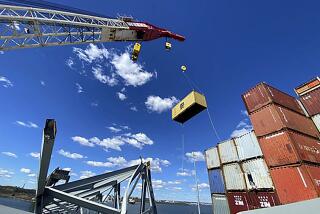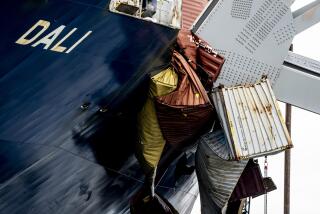First Batch of Traveling Trash Goes into Brooklyn Incinerator
- Share via
NEW YORK — The first bales of the nation’s best-known garbage collection were unloaded, inspected and burned Tuesday after being towed 6,000 miles on a barge, rejected by six states and three nations, challenged in court and lampooned on television.
“Good riddance,” city sanitation Commissioner Brendan Sexton said as he oversaw the work at the Southwest Brooklyn Incinerator.
Probed With Pitchforks
Bulldozers broke up the bales, and a half-dozen environmental workers in white suits and masks probed the debris with pitchforks before it was burned.
It was the beginning of the end of the five-month saga of the garbage barge. Incineration of the 3,186 tons of trash is expected to take about two weeks, and the ashes will be trucked away to be buried at a landfill at Islip, on Long Island.
The load of commercial trash from Islip, New York City and Nassau County began its voyage after it was turned away from the Islip landfill for lack of space.
While it provided material for comedians and news reports, the garbage may leave a more lasting legacy: Some officials said the publicity helped to convince the public that waste disposal is a worsening problem.
“We used it every chance we could to say there is a garbage crisis,” Sexton said. “You can’t wish it away. You can’t demonstrate it away. This helps people visualize that there’s nowhere else to put the garbage.”
The barge set out on March 22 from a private dock in Queens. Lowell Harrelson of Bay Minette, Ala., planned to unload it at a trash-to-methane gas operation in North Carolina. He hoped to demonstrate that it was cheaper to move garbage by water than over land.
Voyage of Rejection
The barge was turned away from the North Carolina landfill, however, for lack of proper permits. That started the 6,000-mile trip, on which the cargo met with angry rejections from Alabama, Mississippi, Louisiana, Texas, Florida, Mexico, Belize and the Bahamas.
Public officials who turned the barge away said they feared that the trash contained infectious wastes or other hazardous materials, but, as the first 30 bales were unloaded Tuesday, inspectors picked out only an empty tar can, which they set aside so its contents could be checked.
“Most of it, frankly, looks like everyday trash,” Sexton said. “There’s an Oreo box, some potato chips. We don’t expect to find anything.”
More to Read
Sign up for Essential California
The most important California stories and recommendations in your inbox every morning.
You may occasionally receive promotional content from the Los Angeles Times.













